翻译理论与实践第九讲
- 格式:ppt
- 大小:39.50 KB
- 文档页数:13
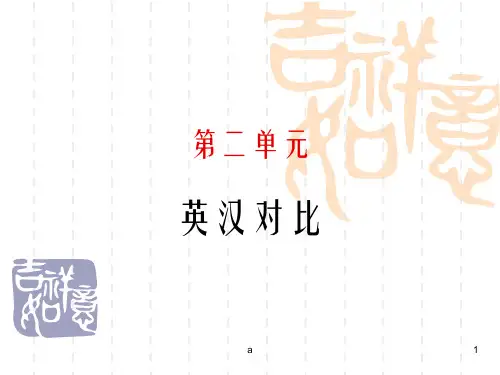
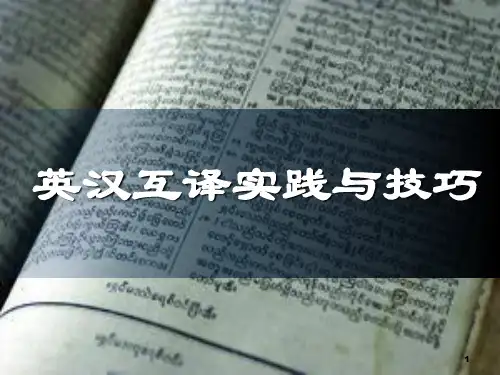
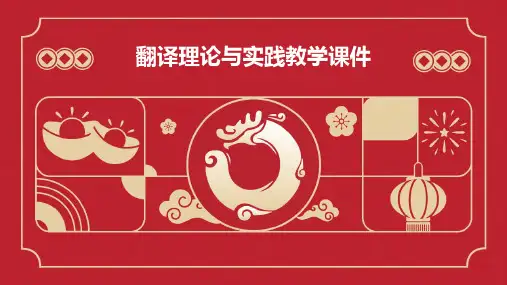



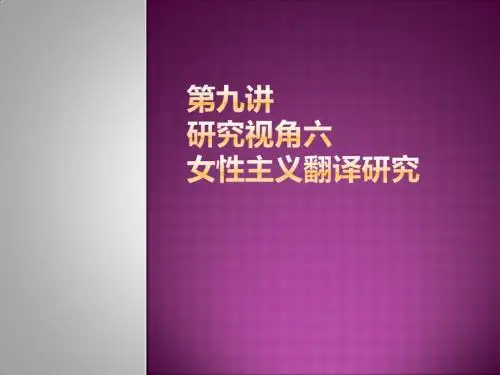



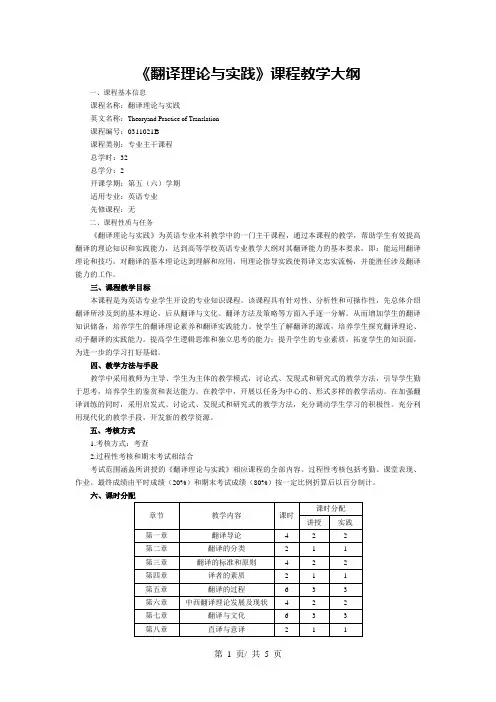
《翻译理论与实践》课程教学大纲一、课程基本信息课程名称:翻译理论与实践英文名称:Theoryand Practice of Translation课程编号:0311021B课程类别:专业主干课程总学时:32总学分:2开课学期:第五(六)学期适用专业:英语专业先修课程:无二、课程性质与任务《翻译理论与实践》为英语专业本科教学中的一门主干课程,通过本课程的教学,帮助学生有效提高翻译的理论知识和实践能力,达到高等学校英语专业教学大纲对其翻译能力的基本要求,即:能运用翻译理论和技巧,对翻译的基本理论达到理解和应用,用理论指导实践使得译文忠实流畅,并能胜任涉及翻译能力的工作。
三、课程教学目标本课程是为英语专业学生开设的专业知识课程。
该课程具有针对性、分析性和可操作性,先总体介绍翻译所涉及到的基本理论,后从翻译与文化、翻译方法及策略等方面入手逐一分解。
从而增加学生的翻译知识储备,培养学生的翻译理论素养和翻译实践能力。
使学生了解翻译的源流,培养学生探究翻译理论、动手翻译的实践能力。
提高学生逻辑思维和独立思考的能力;提升学生的专业素质,拓宽学生的知识面,为进一步的学习打好基础。
四、教学方法与手段教学中采用教师为主导、学生为主体的教学模式,讨论式、发现式和研究式的教学方法,引导学生勤于思考,培养学生的鉴赏和表达能力。
在教学中,开展以任务为中心的、形式多样的教学活动。
在加强翻译训练的同时,采用启发式、讨论式、发现式和研究式的教学方法,充分调动学生学习的积极性。
充分利用现代化的教学手段,开发新的教学资源。
五、考核方式1.考核方式:考查2.过程性考核和期末考试相结合考试范围涵盖所讲授的《翻译理论与实践》相应课程的全部内容。
过程性考核包括考勤、课堂表现、作业。
最终成绩由平时成绩(20%)和期末考试成绩(80%)按一定比例折算后以百分制计。
六、课时分配七、教学内容第一章翻译导论(4学时)【教学目标】1.明确翻译的定义2.熟悉翻译的本质3.了解翻译的起源和意义【教学内容】1.关于翻译的比喻2.翻译的定义3.翻译的起源和意义【教学重点】1.从关于翻译的比喻入手,了解翻译的本质2.从《巴别塔的故事》中了解翻译的起源和意义【教学难点】从语言学、文化、文学、交际学、语义学等层面剖析翻译的定义【学时数】1.课堂讲述2学时2.课堂讨论、习题讲解2学时第二章翻译的分类(2学时)【教学目标】1.熟悉不同层面上翻译的分类方式2.明确每种分类的原则和基本内容3.掌握每种分类方式的区别与联系【教学内容】语言、语言符号、翻译模式、源语文体和翻译变体等五种层面上翻译的分类【教学重点】1.语言、语言符号、翻译模式、源语文体和翻译变体等五种层面上翻译的分类2.每种分类的原则和基本内容【教学难点】对文学翻译和非文学翻译的要求的区别【学时数】1.课堂讲述1学时2.课堂讨论、习题讲解1学时第三章翻译的原则和标准(4学时)【教学目标】1.明确掌握中西方翻译学者所提出的各种翻译标准和原则2.比较中西方翻译学者所提出的翻译标准和原则的区别与联系【教学内容】1.中国翻译学者提出的翻译标准和原则2.西方翻译学者提出的翻译标准和原则【教学重点】中西方翻译学者所提出的各种翻译标准和原则,如严复的“信、达、雅”、泰特勒翻译三原则、奈达的功能对等【教学难点】对比两种翻译原则的异同,如严复的“信、达、雅”与泰特勒的三原则【学时数】1.课堂讲述2学时2.课堂讨论、习题讲解2学时第四章译者的素质(2学时)【教学目标】1.了解译者的责任2.熟悉译者应具备的素质3.了解口译员应具备的特殊素质【教学内容】1.译者的技术责任及社会和文化责任2.译者的素质3.口译员的特殊素质【教学重点】1.译者普遍应具备的素质,如思想政治素质、职业道德、系统知识储备及合理的应用能力等2.口译员应具备的特殊素质【教学难点】译者普遍应具备的素质,如思想政治素质、职业道德、系统知识储备及合理的应用能力等【学时数】1.课堂讲述1学时2.课堂讨论、习题讲解1学时第五章翻译的过程(6学时)【教学目标】1.明确了解关于翻译过程几种观点,并掌握奈达与贝尔的观点2.重点掌握翻译的过程、理解的特点、理解与表达的关系及校对的内容【教学内容】1.西方的几个翻译过程模式2.翻译过程的三步骤【教学重点】1.翻译过程的三步骤2.尤金▪奈达关于翻译过程的代表观点3用心理语言学及诠释学的理论解释翻译过程【教学难点】翻译过程中理解与表达的关系【学时数】1.课堂讲述3学时2.课堂讨论、习题讲解3学时第六章中西翻译理论发展及现状(4学时)【教学目标】1.了解中西翻译史2.了解中西翻译理论发展及现状3.了解中外著名翻译理论家及其翻译思想【教学内容】中国翻译简史西方翻译简史中西方翻译理论研究现状【教学重点】1.中西方翻译高潮2.中外著名翻译理论家及其翻译思想【教学难点】中西方著名翻译理论家及其翻译思想【学时数】1.课堂讲述2学时2.课堂讨论、习题讲解2学时第七章翻译与文化(6学时)【教学目标】1.了解翻译中文化因素的渗透2.了解翻译中文化的差异及转换【教学内容】1.汉英翻译与文化2.中英思维方式对比3.汉英语言对比【教学重点】1.语言与文化的密切关系2.中西方语言文化差异3.翻译中的文化转换【教学难点】1.汉英语言对比2.翻译中的文化转换【学时数】1.课堂讲述3学时2.课堂讨论、习题讲解3学时第八章直译与意译(2学时)【教学目标】1.了解直译与意译的含义2.了解直译与意译的功能3.了解翻译中直译与意译相结合的方法【教学内容】1.直译与意译的定义2.直译与意译的特点、功能、冲突与协调3.直译与意译的适用条件【教学重点】1.直译与逐字译的区别2.意译的含义3.直译与意译的功能【教学难点】直译与意译的功能及适用条件【学时数】1.课堂讲述1学时2.课堂讨论、习题讲解1学时第九章归化与异化(2学时)【教学目标】1.了解归化与异化的概念及其历史沿革2.正确认识翻译中的归化与异化问题3.学会在翻译实践中恰当运用归化与异化策略【教学内容】1.归化与异化的概念2.“归化”与“异化”同“直译”与“意译”的异同3.技术层面上的归化与异化处理【教学重点】1.归化与异化的概念及其历史沿革2.学会使用归化和异化的翻译策略【教学难点】在翻译实践中恰当运用归化与异化策略【学时数】1.课堂讲述1学时2.课堂讨论、习题讲解1学时八、教材及主要参考书[1]Newmark,P. .A Textbook of Translation. Shanghai: SFLEP, 2001.[2]Nida,E. A. Language, Culture, and Translating. Shanghai: SFLEP, 1993.[3]Nida,E. A. Language and Culture: Contexts in Translating. Shanghai:SFLEP,2001.[4]陈宏薇. 新实用汉译英教程. 湖北:湖北教育出版社.2000.[5]冯庆华. 实用翻译教程(英汉互译. 上海:上海外语教育出版社.2002.[6]姜倩,何刚强. 翻译概论. 上海:上海外语教育出版社.2008.[7]谢天振,何绍斌. 简明中西翻译史. 北京:外语教学与研究出版社.2013.。
翻译理论与实践(Translation theory and Practice)This paper consists of the 8888 contributionPpt documents may experience poor browsing on the WAP side. It is recommended that you first select TXT, or download the source file to the local view.Translation theory and PracticeI., What, is, translation, II., Is, it, to, translate, easy, III.,, Can, all, the, translated, words, be?I., What, is, translation?1, the definition of translation? 2, translation is to translate the text or? E.g.1:, My, sister, went, to, school, at, 7., e.g.2:, have you eaten? Where to? E.g.3: you're beautiful today! -- where?!II., Is, it, easy, to, translate?Henchman? Go back to man in the? The? Street? Crow s feet a hen party '? Fog lock hill mountain fog water disappears in the sky with rain window, two East West three point cut to carve up the piece, seven horizontal eight vertical knife knife toward the sea towards towards falling towards long clouds long long.III., Can, all, the, words, be, translated?According to the nephew lanterns (old uncle)? East sunrise rain, is (clear) the situation is a (clear)? --The professor shouted:Gentlemen, order --The entire class yelled:! "" Beer! "--Why is the river very? Rich? --Because it has two banks.You can cage a swallow, but you can t swallow a "cage. --The secret is going to? Be exposed, and we ll look pretty silly. --You" already look pretty and silly. bathing on bikini? Girl, eyeing, boy, finds boy eyeing bikini on bathing girl.Chapter 1The definition of translation, the purpose of translation, the type of translation, the standard of translation, the process of translation, the conditions for translationDefinition of translationTranslation is the practice of language in which the content of another language is re expressed in one language. Feng Qinghua? Translation is a kind of language (i.e., primitive) information in another language (the target language) express, so that the readers can get the original thoughts expressed by the author, are roughly the same as the original readers feel. - Fan Zhongying, translation is the translator's re understanding of the same thing and the use of another text. - Qiao HaiqingDefinition of translationTranslation is "an interpretation of verbal signs by means of some other language Translation is." Jakobson? "The replacement of textual material in one language (SL) byequivalent textual material in another language (TL). Catford Translation is the replacement of? A representation of a text in one language by a representation of an equivalent text in a second language. HudsonThe purpose of translationA bridge of communication and communication between different languages and cultures.Types of translationIntra language translation (intralingual translation) an interpretation of verbal signs by means of other signs in the same language (interlingual translation) translation? An interpretation of verbal signs by means of some other language? Intersemiotic translation (intersemiotic translation) an interpretation of verbal signs by means of nonverbal signs systemChinese translation theoriesYan Fu: Xindaya translation - Three: xindaya. It is hard to ask for a letter. Take care of the letter and fail to reach it,Even if you do not translate it, you will also interpret it. ? Lu Xun: faith, Shun - a course to make it easy, one is to preserve the original charm. / / faith rather than fluency? Qu Qiubai: the notion of equivalence translation should be the original intention, exactly China introduced to readers, make readers get China concept concept equal to other language from the textto the reader. Contradiction: to reproduce the artistic conception the highest task of literary translation is to reproduce the artistic conception so that the target readers can enjoy the beauty as much as the original.Chinese translation theoriesLiu Zhongde: letter, reach, cut letter: believe in content: as long as it is cut: to adapt to style, Zhang today: true, good, beautiful, truth: truth, principle, good: ideological principles: Beauty: artistic principlesForeign translation theoriesTytler: 1. The translation should the same effect on give a complete transcript of the ideas of the original work. style and manner of 2. The writing should be of the same character as that of the original. translation should have all 3. The the ease of the original composition.Federov: on Translation should produce a translation version which may be read with as much pleasure as the original, and yet remain faithful to its spirit, sense and style. Nida: dynamic equivalence theory readers get responses, and feelings with the original readers read the original income roughly equal. Newmark: text centered theoryProcess of translationIt is generally believed that the original text is understood expression Nida: original text testAnalytical translationTarget textRestructureFour steps: analysis, translation, reconstruction, testTranslation, from, English, to, Chinese:1., The, days, run, into, weeks., the days go by, for a few weeks.2. It, s, all, Greek, to, me., the translation condition, I do not understand at all. Mandarin Chinese is better than3. Mary has? A clever tongue. Marie (glib glib). English language ability is better than4., You, can, never, tell., wide knowledge, no one can say.5., My, memory, failed, me, at, that, moment., I can't remember that moment.6., Your, name, obstinately, escapes, me., I can't remember your name.7., To, think, that, you, should, fail., I don't think you will fail. 8., Would, it, were, otherwise, if that's not the case. There was more mischief than harm in him. he is only mischievous, and no harm. 10., I, never, go, past, my, old, school, but,, think, of, our, headmaster.. Every time I pass my alma mater, I remember our headmaster. 11., The, book, is, beyond, me., I can't read this book. 12., There, is, nothing, like, leather, for, shoes., leather shoes are great. 13., It, is, too, recent, to, be, forgotten., fresh in memory.14., The, mountain, is, not, valuable, because, it, is, high.,mountain is precious, not at its height. The "This is the last place I where expected to meet you." did not expect to meet you here. 16., He, is, nothing, if, not, stubborn., he's a stubborn man. 17., I, was, not, a, little, surprised., I was shocked.18., He, can, do, it, if, any, one, can., only he can do it.19. You cannot make something out of nothing. one can't make bricks without straw. 20., I, can, t, bear, the, sight,, of, that, man.I can't stand seeing that man.Similar sentences1. He had made a box., he has made a box. He had a box made., he told people to make a box.2. Foolishly he spoke. he was so foolish to speak. He spoke foolishly. he talks very stupid.3. Quite properly he was punished. he deserved to be punished. He was punished quite properly., he was properly punished.4., We, asked, him, to, speak, from, his, experience., we ask him to talk about it based on his experience. We asked him to speak about his experiences. we asked him to talk about his experience.Similar sentences5. He is behind time. he's late. He, is, behind, the, times., he's behind the times.6. His success is out of question. his success is beyond doubt. His, success, is, out, of, the, question, he's never going to be successful.7., They, went, to, sea., they're going to besailors. They, went, to, the, sea., they went to the beach. 8., It, has, been, raining, continually, for, two, days., rain, intermittent two days. It has, been, raining, continuously, for,, two, days rain continued for two days.Similar sentences9., He, has, no, more, than, ten, books., he has only ten books. He has not more than ten books., he has ten books at most.He is not a little afraid of it. he was very scared. He is not a bit afraid of it., he is not afraid at all. 11., I, didn, t, go, because, I, was, afraid., I am not afraid to go. I, didn, t, go, because, I, to., was, afraid, I did not go, because I dare not go. 12. She kept the house., she watches over the house. She kept house. her home.Similar sentences13., This, is, no, place, for, me, to, go., this is not whereI should go. There, is, no, place, for, me, to, go, I have nowhere to go. 14. I, had, a, good, talk, to, him, yesterday., I gave him a good dressing down yesterday. I had a good talk with him yesterday. I had a really good time talking to him yesterday. 15., Tom, escaped, prison., Tom escaped the jail. Tom, escaped, from, prison., Tom, jailbreak. 16., Is, there, any, difficulty, in, this? Do you have any difficulty with this? Is, there, some, difficulty, in, this? It's a bit difficult, isn't it?Similar sentencesWe are sure that man is mortal. we are sure that man will always die. We, are, sure, that, man, is, dead., we are sure the man is dead. 18., We, hired, the, boat, by, the, hour.. We ship by hour. We hired, the, boat, for, an, hour., we rented an hour boat.Similar sentences19., I, did, not, notice, him., I didn't notice him. I, took, no, notice, of, him., I don't care about him. 20., Happily, he, did, not, die., thankfully he did not die. He did not die happily., he died uneasy.The second chapter is semantic translationFirst, the choice of meaning in the understanding of polysemy (polysemy)The translation of runRun, a, car, run, shop, run, oil, run, message, a, fever, run, a, computer, run, run, a, meeting, run,, chickens, run, a, arms, advertisement, run, anHead translation10. He arranged his speech under five heads. his speech is divided into five parts. 11., We, have, thirty, head, of, cattle.We have thirty cows. 12., Heads, or, tails? Heads or tails? 13., Where, is, the, head? Where is the toilet?The translation of head:1. head of the English Department, director of the English Department of2. head of the government head of the bed, head of government3.4. head of the staircase a of the needle at the top of the stairs5. head6. He was badly wounded in a the head. he was badly wounded in the head.7. He has a good head for maths. he has a lot of mathematical talent.8., You, should, use, your, head., you should use your head.9. The, dinner, cost, US, five, dollars, a, head., the meal cost us 5 yuan each.The translation of I. poor:1. The, cloth, is, poor, in, quality., this cloth is of poor quality.2. The, water, is, poor, in, oxygen., this water is anoxic.3. Her first concert had a poor audience., her first concert, with very few listeners.4. This, to, her, was, a, poor, consolation., this comfort does not work for her.5. In my poor opinion, you should let her go. in my humble opinion, you should let her go. Boat. She was a poor sailor and always went to bed immediately on on getting the she has seasickness problems, so always go to bed on board.The translation of II. runThe He will not be running in the next election., he is not ready to run for the next election. 2., The, train, is, not, running, today., that train is off today. 3. The film began to run. filmat the. 4. His face was running with sweat. he Sweat streamed down the face. 5., It, was, such, a, ran., hot, day, that, the, butter, the weather was so hot that the butter melted. 6., The, road, runs, north., this road extends north. The "The rumor runs that he is going to resign." is rumoured that he is going to resign. 8., The, monsoon, had, six, weeks, more, to, run., the rainy season will last six weeks.The translation of II. run9., The, car, repair, will, run, you, at, least, two, hundred., repair, at least you spend two hundred yuan. 10. The play ran for only a week in that theatre.. The play was only staged for a week in that theater. 11., Potatoes, are, running, large, this, year., potatoes grow a lot this year. 12., A, freezer, doesn, run., t, cost, much, to, the use of the refrigerator is not very expensive.The translation of III. liveShe needs to find somewhere to live. she needs to find a place to live. 2., Where, do, these, plates, live? Where are these dishes? 3., Spiders, can, live, for, several, days, without, food., spiders can live without food for a few days. 4., We, saw, a, real, rattlesnake, live! We saw a live rattlesnake.The translation of III. live5. The club has live music most nights., the club has live music most nights.6. The show is going on live., the show is being broadcast live.7., Pollution, is, still, very, much, a, live,issue. pollution is still a very interesting issue at the moment.8., This, is, a, live, and, interesting, book., this is a lively and interesting book.The translation of IV. like1., He, likes, mathematics, more, physics., than, he prefers mathematics to physics.2., Bananas, don, t, like, me., I ate a banana and my stomach was upset. (bananas do not fit my stomach.) Three它的味道像芒果。
翻译理论与实践讲义翻译理论与实践讲义第一章绪论Definition of translation1. Translation may be defined as follows: the replacement of textual material in one language (SL) by equivalent textual material in another language (TL). --Catford2. To translate is to change into another lang uage, remaining the sense.‖ -- Dr. Samuel Johnson3. Translation consists in reproducing in the receptor language the closest natural equivalence of the source language, first in terms of meaning and secondly in terms of style. --EugeneA. Nida 尤金奈达1. Her mother died of difficult labor.2. This is a very good price.3. Millet made a portrait of Lady Chesterfield, which flatter her.4. He always lives ahead of his salary.第二章翻译的过程1. 阅读并分析原文(analysis )2. 将原文转为译入语(transfer )3. 对译文进行修订(proofreading)2.1 阅读并分析原文2.1.1 原文的意图一.语法结构的选择二.形式对意义的表达例如诗歌等三、语义分析(semantic analysis )a. 词的概念意义(conceptual meaning)和关联意义(associative meaning )①chair the board meeting②seat oneself in a wooden chaira sharp knife a sharp child a sharp turn sharp eyesb. 把握意义关系,注意同反义、褒贬义、多歧义关系。